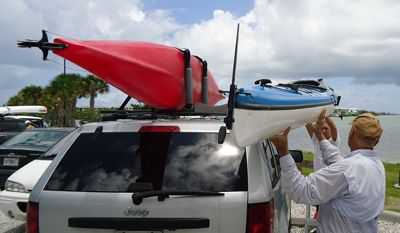“Take Me to the River”
By paddling enthusiast and kayak hoarder Jack Roberts
Ye-hah! You finally bought your first kayak. “Another life ruined”, as we say to new victims of the paddling addiction. Maybe you bought yourself a factory fresh Kevlar-composite work of hydrodynamic art, or maybe you read my last article and overcame “Failure to Launch” by finding a suitable used rec-boat. Maybe you couldn’t resist the ultra-light carbon fiber adjustable feather paddle and the low profile side-entry Cordura PFD with a waterproof holder for your GPS unit, or maybe you’ll be easing in to it with the aluminum shaft/plastic blade stump knocker and the orange horse collar Type II vest that came along as part of your deal. No matter. You’ve made the move. Welcome to the fleet.
So, now what do you do? Well, if you didn’t use a pick-up truck and still managed to get your kayak home, then you have probably devised a transport system that will enable you to use the roof of your vehicle to get your boat to and from the water. If you haven’t, then you have some more decisions to make. The foam “wedge block” and strap carrying kit you may have seen (or purchased) at the kayak shop is a functional, inexpensive choice for short hauls, but a solid, reliable roof rack system is something you will eventually want. If you plan on regularly carrying your boat more than a few miles, and if you’ll be travelling at high speeds, it is something you will eventually need. There are quite a few manufacturers of good, adaptable roof gear out there, but the two major producers of kayak rack systems for passenger vehicles, Thule and Yakima, offer the widest assortments of well-engineered attachment brackets, crossbars, hull cradles and other accessories. Their catalogs and websites will introduce you to a new world of useful and intriguing gadgetry. They maintain technical assistance phone lines manned by enthusiastic people who know what they are talking about and can to tell you exactly which of their components will work with your particular vehicle. They sell through local dealerships, they provide excellent warranty service, and their goods cost a substantial amount of money. In fact, if you have purchased a used kayak, a complete rack system from either company may cost as much as your boat did. Nevertheless, these products work, and I recommend them.
Now, the racks are on and you’re ready to load up. While this might sound like an easy task, beginners often run into problems here. This why we have YouTube. Go there and type “kayak loading” into the search box. You will be presented with quite a number of helpful videos on the subject, and I will be spared the task of using the proverbial 1000 words to try and describe a procedure that is not really hard to execute, but is fairly hard to explain.
And, at last, you’re ready to go. But, you ask, where? Unlike my home state of New Jersey, Florida provides us with so many public launching sites on so many different types of water that it is sometimes difficult for experienced paddlers to decide which ones to use. As a newbie, though, you will want to start developing your skills and building confidence on quiet, sheltered waters. If you have paddling friends, possibly the same people who seduced you into this new pleasure, take advantage of their experience. They should be able to suggest venues for your initial trips. If you promise brownies or an après trip beer, they may actually agree to accompany you. And even if you are on your own, there’s still no problem. Local kayak dealerships and bait shops that are involved in kayak fishing (and more and more of them are) can be great resources. If you stop in at an off hour, (not on Saturday morning) and make your needs known, a conversation will likely blossom. Listen more than you speak, and you will almost certainly come away with the information you need.
But maybe I can make things even simpler. I often get the chance to take new paddlers on their rst trips, something I enjoy doing very much. Here are a few of the beginnerfriendly places along the Treasure Coast that I take them to. Naturally, all of these launching areas are less crowded on weekdays.
- Cove Road Park in Stuart; Indian River – Stay out of the Intracoastal channel; there’s plenty of safe paddling water on the west side of the “Great Pocket”. Head south toward Peck Lake. We often see dolphins in this area.
- Sewall’s Point Municipal Park; Indian River – Keep to the west side of the river and paddle south through the canals and islands.
- Round Island Riverside Park in Vero Beach: Indian River – Commune (from a comfortable distance) with the manatees as you enjoy the several di erent routes through the mangroves.
- Jonathan Dickinson State Park in Hobe Sound; Loxahatchee River – Put in at the boat ramp and paddle upstream (to the right) toward “Trapper Nelson’s”. As with most bodies of fresh and brackish water in Florida, there be ‘gators here. There is also a concession area where you can rent kayaks if you need them. A fee is charged for park entry.
I’ll be providing more detailed information about these and other paddling spots in the “Tips and Trips” section of future articles, but in the meantime, I think you’re ready to “Get out and Paddle”.
To reach Jack Roberts, email treasurecoast@coastalanglermagazine.com.
